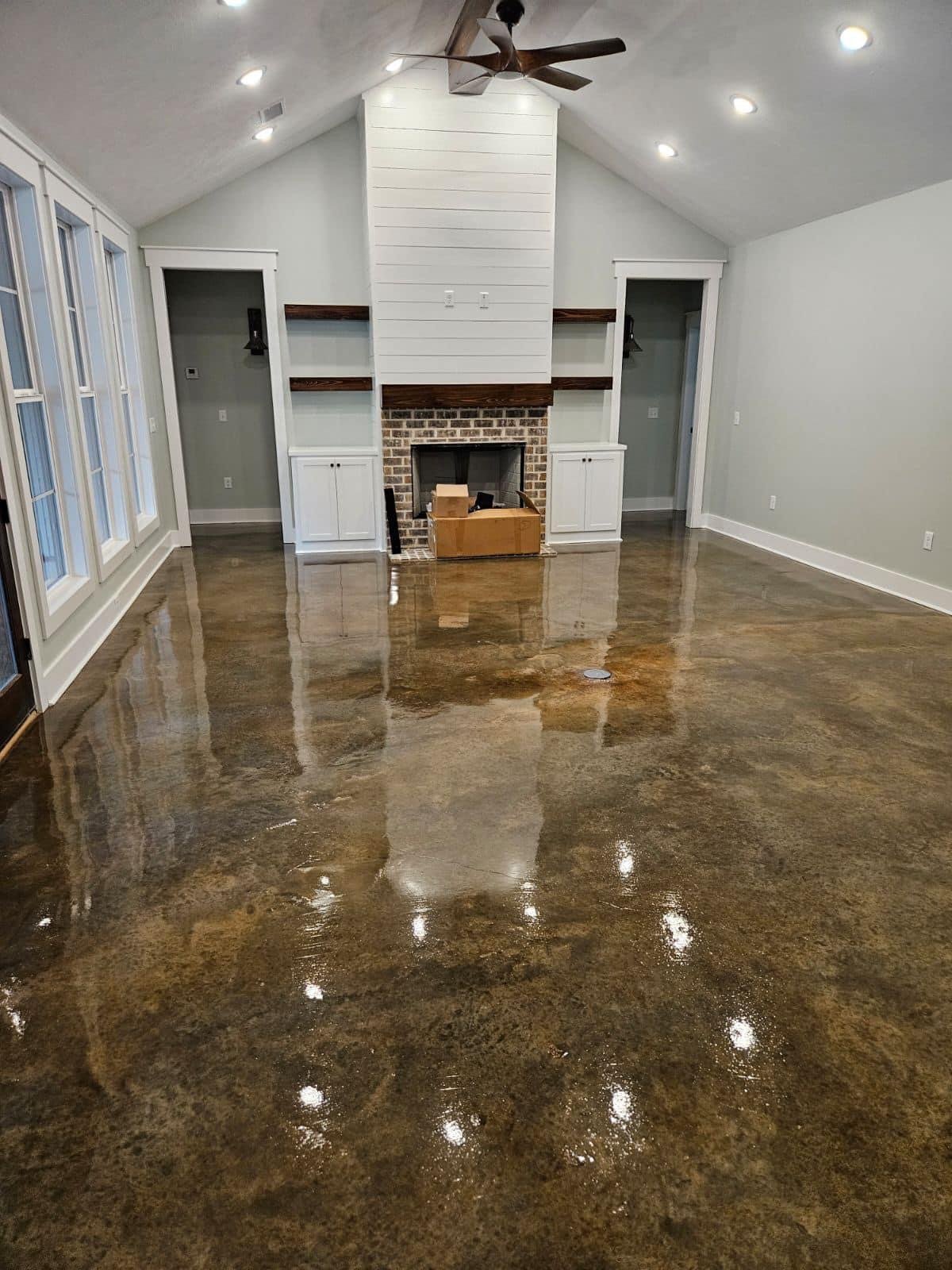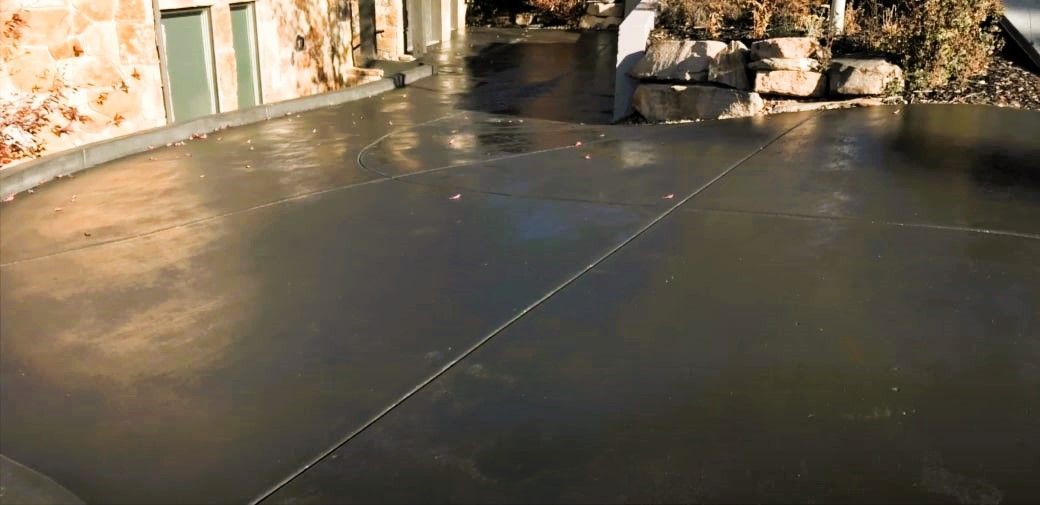The complete handbook to stained concrete and its design potential
Recognizing the Different Kinds of Stained Concrete for Your Next Job
Stained concrete offers different alternatives that cater to various aesthetic and practical needs. Each kind presents unique qualities that affect the last look and longevity of the surface. Understanding these differences is vital for any person preparing a project. From rich, chemical responses of acid-based stains to the vivid uniformity of solid color stains, the options can substantially influence the result. What variables should one consider when selecting the suitable tarnish for their specific needs?
Overview of Stained Concrete
Stained concrete acts as a versatile flooring option that can improve the aesthetic appeal of numerous areas. This strategy includes using a coloring representative to the surface area of existing concrete, enabling a wide range of layout possibilities. Stained concrete is popular in both residential and business settings, providing a resilient and low-maintenance option that can mimic the appearance of all-natural products like stone or floor tile.
The staining process can be performed utilizing water-based or solvent-based items, each providing distinct visual effects. The last look is affected by variables such as the original concrete surface, the kind of tarnish made use of, and the application technique. Stained concrete not just enhances exterior and interiors yet also advertises sustainability by rejuvenating existing concrete frameworks. As an outcome, it has gotten grip amongst homeowners and developers looking for both performance and style in their flooring selections.
Acid-Based Stains: Features and Advantages

Unique Color Variants
Concrete surface areas can change significantly with the application of acid-based stains, which use a rich palette of special shade variants. These stains permeate the concrete, reacting chemically to produce dynamic planet tones that range from deep browns and reds to soft eco-friendlies and blues. The resulting tones are commonly variegated, developing a natural, marble-like appearance that boosts the concrete's personality. Each application yields distinct results as a result of variations in the concrete's composition and the discoloration method used, making every project distinct. Additionally, acid-based stains can be split or combined with other methods to produce customized styles, permitting for individual expression. This adaptability makes acid-based stains a prominent option for both household and commercial applications.
Chemical Reactions Discussed
While many variables add to the efficiency of acid-based stains, the underlying chemical responses play a vital function in their unique attributes and benefits. These stains largely contain water, acid, and metal salts. When put on concrete, the acid responds with the calcium hydroxide in the cement, creating a chemical makeover that causes long-term color changes. The metallic salts penetrate the surface and bond with the concrete, permitting for a broad array of shades and tones. This response not just boosts visual charm yet likewise provides durability, making the shade immune to fading and wear. In addition, acid-based stains can develop a variegated surface that imitates natural stone, more improving their popularity for attractive concrete applications.
Surface Preparation Value
Achieving excellent results with acid-based stains hinges on extensive surface prep work. This necessary action assurances that the concrete surface area is tidy, totally free of contaminants, and effectively profiled for suitable tarnish absorption. Any kind of existing sealants, dirt, or oils can prevent the chemical response that creates the preferred shade and coating, causing irregular or irregular outcomes.
Prior to using the tarnish, the concrete should be mechanically cleaned or pressure washed, complied with by a thorough examination for cracks or blemishes that might require fixing. In addition, confirming the surface area is appropriately dried will certainly improve stain adherence. By prioritizing these preparatory measures, the long life and vibrancy of acid-based stains can be significantly boosted, causing a more cosmetically pleasing and resilient finish.
Water-Based Stains: Functions and Advantages

Water-based stains pass through the concrete, offering a much more transparent surface that highlights the all-natural structure and variants of the surface area below. They are available in a large selection of colors, permitting creative flexibility in design. In addition, water-based stains are much easier to clean up, requiring only water and soap, which streamlines the application process.
Their quick drying out time improves effectiveness, making them a functional choice for both do local stained concrete it yourself enthusiasts and specialists. Overall, water-based stains offer an appealing mix of aesthetic adaptability and easy to use residential or commercial properties, making them a prominent option for concrete improvement projects.
Strong Color Stains: Vibrant Options for a Bold Appearance
Strong color stains supply a reliable remedy for those looking for to develop a strong and dynamic aesthetic on concrete surface areas. These stains supply a consistent pigmentation that can dramatically enhance the visual allure of floorings, patio areas, and driveways. Offered in a large spectrum of colors, strong color stains enable for imaginative expression, catering to numerous layout choices.
Among the essential benefits of strong color stains is their ability to hide flaws, supplying a fresh and refined seek to maturing concrete - stained concrete contractors. Furthermore, their formula generally consists of UV-resistant homes, guaranteeing long life and shade retention even in severe climate condition
Application is uncomplicated, needing marginal preparation of the concrete surface area. Once used, solid color stains can be sealed for added security and luster, further elevating their aesthetic top quality. With their lively options, solid shade stains are an excellent option for those intending for an impactful and cohesive layout.
Semi-Transparent Stains: Attaining Deepness and Measurement
Semi-transparent stains use an one-of-a-kind approach to improving concrete surface areas by supplying deepness and dimension with different shade options. Comprehending the application strategies is essential for accomplishing the desired effect, while appropriate maintenance techniques assure long life. This section will discover these key elements to make the most of the advantages of semi-transparent staining.
Shade Options Available
A wide array of shade choices exists for semi-transparent stains, allowing home owners and designers to boost the all-natural charm of concrete surface areas. These stains can be found in an array of shades, from earthy tones like browns and terracottas to dynamic colors such as blues and greens. The semi-transparent nature of these stains enables the underlying concrete to reveal with, creating an unique depth and dimension that can enhance numerous style aesthetics. In addition, combining different colors can generate personalized tones, enabling a tailored try to find each job. This adaptability makes semi-transparent stains a preferred selection for both exterior and interior applications, as they can harmonize with surrounding elements while adding visual passion to plain concrete.
Application Techniques Clarified
To attain the wanted deepness and measurement with semi-transparent stains, proper application techniques are important. Surface area preparation is critical; the concrete must be tidy and totally free of any kind of impurities. This usually involves power washing and fixing any cracks. Next off, picking the appropriate applicator, such as a sprayer, roller, or brush, can influence the final look. Sprayers permit a much more also application, while rollers can aid accomplish appearance. It is essential to stained concrete floors use the stain in thin, also layers, allowing each layer to completely dry before including one more. Adjusting the application method, such as differing pressure or making use of various tools, can produce one-of-a-kind effects. Ultimately, securing the stained surface area enhances the vibrancy of the shades while offering security.
Maintenance Ideal Practices
Routine maintenance is crucial for preserving the beauty and stability of surfaces treated with semi-transparent stains. To preserve these surface areas, routine cleansing is important. Using a pH-neutral cleaner and a soft-bristle mop will certainly aid eliminate dust and particles without harming the tarnish. It is suggested to prevent severe chemicals, as they can weaken the stain's appearance. Additionally, routine resealing every one to 3 years can protect against wear and fading. This procedure involves cleaning up the surface area thoroughly and applying a suitable sealer designed for stained concrete. Property owners ought to likewise keep track of for any kind of signs of discoloration or damage and address these issues without delay to ensure lasting vibrancy and resilience. Following these ideal practices will enhance the overall life-span of semi-transparent stained surface areas.
Results and Methods: Personalizing Your Stained Concrete
Personalizing stained concrete entails a selection of strategies that enhance both visual appeals and capability. Amongst these techniques, layering different discolor colors can create depth and intricacy, permitting unique visual impacts. Strategies such as acid discoloration provide a variegated look, while water-based stains provide a much more consistent appearance.
Additionally, including decorative patterns, such as stenciling or inscription, can better customize the surface area, adding intricate layouts that satisfy specific preferences. Texturing the concrete, whether via stamping or mop finishes, presents responsive aspects that not only enhance grip however additionally enhance aesthetic rate of interest.
Moreover, applying sealants can enhance the color vibrancy and give defense against wear. Modification methods expand past simple color; they can transform a standard concrete slab right into a stunning prime focus, making it appropriate for both household and business areas. With cautious choice of results and methods, stained concrete can accomplish a genuinely tailored look.
Maintenance and Longevity of Stained Surfaces
Stained concrete surface areas are known for their durability and visual charm, preserving their honesty is important for guaranteeing longevity. Routine cleansing is vital; sweeping and mopping with a pH-neutral cleaner aids stop dirt build-up and staining. In addition, applying a sealer every couple of years can shield the surface area from wetness, chemicals, and UV damages, consequently enhancing its lifespan.
It is also important to resolve any type of cracks or chips promptly. Little repair work can mitigate further degeneration, preserving the aesthetic and structural top quality of the surface. For exterior stained concrete, seasonal upkeep, anchor such as eliminating snow and ice, is essential to avoid surface area damage from freeze-thaw cycles.
Regularly Asked Questions
Can I Tarnish Existing Concrete Surfaces or New Ones?
The inquiry of whether existing concrete surface areas can be stained develops often. It is certainly possible to stain both brand-new and old concrete, provided the surface is effectively ready and complimentary of pollutants for perfect adhesion.
How much time Does the Discoloration Process Typically Take?
The staining procedure normally takes one to 3 days, depending upon aspects such as surface area prep work, kind of tarnish, and weather conditions. local stained concrete. Healing time might prolong beyond first application, affecting the general duration significantly
Is Stained Concrete Safe for Outdoor Usage?
Stained concrete is normally safe for outside usage, supplied it is correctly secured. This securing shields against wetness and UV damages, guaranteeing longevity and security, while likewise boosting the aesthetic appeal of exterior rooms.
Can I Apply Several Discoloration Layers for Various Results?
Using multiple stain layers can achieve varied impacts on stained concrete. It is important to ensure compatibility in between stains and permit correct drying out time in between applications to avoid unintended responses or discoloration.
Exist Any Type Of Color Limitations for Stained Concrete?
Color restrictions for stained concrete primarily rely on the kind of stain made use of, with water-based stains using a more comprehensive combination contrasted to acid-based stains. stained concrete floors. Accomplishing vivid colors might call for mindful choice and application strategies.